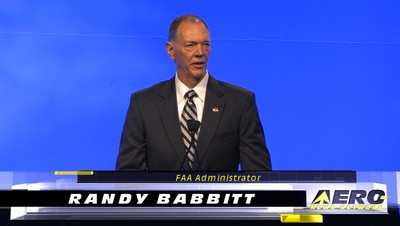Sat, Nov 13, 2010
Seeks To Prevent "Widespread Fatigue Damage" In Aircraft Over
75,000 Pounds
 The FAA has finalized a rule designed to protect most of
today's commercial planes and those designed in the future from
structural damage as they age, in what the agency calls a
continuing effort to address aging aircraft issues.
The FAA has finalized a rule designed to protect most of
today's commercial planes and those designed in the future from
structural damage as they age, in what the agency calls a
continuing effort to address aging aircraft issues.
The new rule seeks to prevent "widespread fatigue damage" (WFD) by
requiring aircraft manufacturers and certification applicants to
establish a number of flight cycles or hours a plane can operate
and be free from WFD without additional inspections for fatigue.
Manufacturers have between 18 and 60 months to comply depending on
the particular aircraft type.
Once manufacturers establish these limits, operators of affected
aircraft must incorporate them into their maintenance programs
within 30 to 72 months, depending on the model of aircraft. After
the limit is in the maintenance program, operators cannot fly the
aircraft beyond that point unless the FAA approves an extension of
the limit."
Safety is our highest priority. This rule provides a
comprehensive approach to the problem of widespread fatigue in
aging aircraft," said U.S. Transportation Secretary Ray LaHood.
"Requiring carriers to regularly inspect their aircraft for
possible fatigue is essential to ensuring the highest levels of
safety."
"We've addressed the problem of aging aircraft with numerous
targeted regulations and 100 airworthiness directives over the
years," said FAA Administrator Randy Babbitt. "This rule is a
comprehensive solution to ensure the structural safety of today's
airliners and the airplanes of tomorrow."

An airplane's metallic structures are stressed and can develop
cracks when they experience repeated loads such as the
pressurization and depressurization that happens on every flight.
While airlines regularly inspect aircraft for cracks exceeding a
certain size, WFD involves aircraft developing numerous tiny
cracks, none of which would have raised concerns individually but
which together run the risk of joining up and impairing the
structural integrity of the plane. The new regulation applies to
airliners with a takeoff weight of 75,000 lbs. and heavier. It also
applies to all transport designs certificated in the future.
The affected models, totaling 4,198 U.S.-registered airplanes,
are listed in the rule. The FAA is working closely with the
European Aviation Safety Agency (EASA) and other national
authorities to harmonize this rule with their regulations as much
as possible. EASA is now developing rulemaking to address WFD, and
the FAA participates in that process.
More News
"Fly-by-wire flight, coupled with additional capability that are being integrated into ALFA, provide a great foundation for Bell to expand on its autonomous capabilities. This airc>[...]
Hold Procedure A predetermined maneuver which keeps aircraft within a specified airspace while awaiting further clearance from air traffic control. Also used during ground operatio>[...]
Aero Linx: B-21 Raider The B-21 Raider will be a dual-capable penetrating strike stealth bomber capable of delivering both conventional and nuclear munitions. The B-21 will form th>[...]
Also: Virgin Galactic, B-29 Doc to Allentown, Erickson Fire-Fighters Bought, FAA Reauthorization After dealing with a big letdown after the unexpected decision by Skyreach to disco>[...]
Also: Skydio Chief, Uncle Sam Sues, Dash 7 magniX, OR UAS Accelerator US Secretary of the Air Force Frank Kendall was given a turn around the patch in the 'X-62A Variable In-flight>[...]
 Aero-News: Quote of the Day (05.09.24)
Aero-News: Quote of the Day (05.09.24) ANN's Daily Aero-Term (05.09.24): Hold Procedure
ANN's Daily Aero-Term (05.09.24): Hold Procedure ANN's Daily Aero-Linx (05.09.24)
ANN's Daily Aero-Linx (05.09.24) Airborne 05.03.24: Advanced Powerplant Solutions, PRA Runway Woes, Drone Racing
Airborne 05.03.24: Advanced Powerplant Solutions, PRA Runway Woes, Drone Racing Airborne-NextGen 05.07.24: AI-Piloted F-16, AgEagle, 1st 2 WorldView Sats
Airborne-NextGen 05.07.24: AI-Piloted F-16, AgEagle, 1st 2 WorldView Sats




